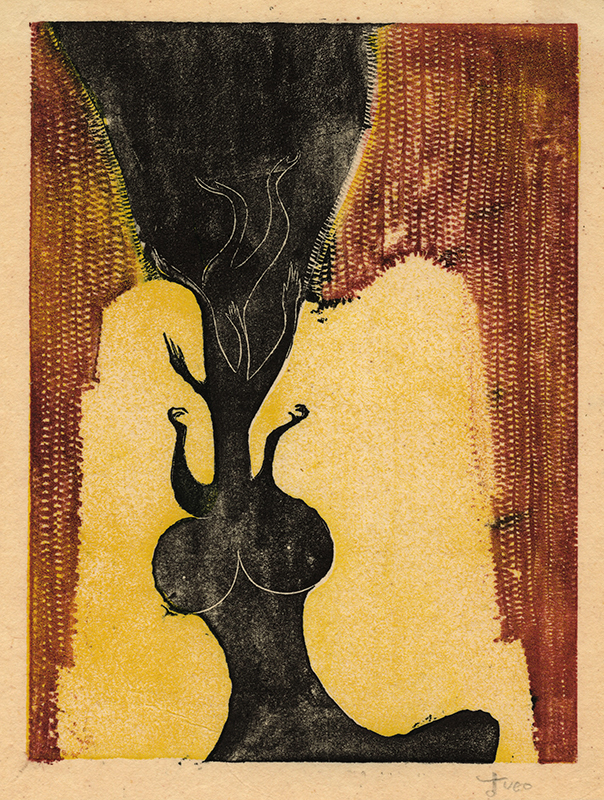
19th, 20th & 21st Century Fine Prints
707-546-7352 · fax 707-546-7924 · web: www.annexgalleries.com · email: artannex@aol.com
African Dream (from: This Hunger) by Ian Hugo

African Dream (from: This Hunger)
Ian Hugo
African Dream (from: This Hunger)
Ian Hugo
1898 - 1985 (biography)This woodcut is a proof from the personal collection of Atelier 17 printmaker Ian Hugo. Hugo, whose given name was Hugh Guiler, was married to the writer Anais Nin.
Hugo and Nin collaborated on a number of literary projects together, one of which was a collection of 5 of Nin's works titled "This Hunger." Published in 1945 by Gemor Press, their own publishing company, the hand made book, done in an edition of 40, contained 5 color woodcuts by Hugo. Later that year the story was expanded and incorporated into her first full length novel, 'Ladders to Fire.'
This image illustrated the first page of the chapter Hejda in 'This Hunger.'
Hugo's childhood was spent in Puerto Rico and the tropical landscape is often reflected in his Surreal imagery, such as "Jungle Book", named for Kipling's childrens' book that evoked such vivid images for so many around the world.
Ian Hugo was born Hugh Parker Guiler in Boston, Massachusetts on February 15, 1898. His childhood was spent in Puerto Rico, which he called a "tropical paradise," the memory of which stayed with him and surfaced in both his engravings and his films. He attended school in Scotland and graduated from Columbia University in New York, where he studied economics and literature.
He was working with the National City Bank when he met and married author Anais Nin in 1923. They moved to Paris the following year where Nin's diary and Guiler's artistic aspirations flowered. Guiler feared his business associates would not understand his interests in art and music, let alone those of his wife, so he began a second life, as Ian Hugo. Ian and Anais moved to New York in 1939. The following year he took up engraving and etching, working at Stanley William Hayter’s Atelier 17, established at the New School for Social Research.
Hugo was one the the early printmakers to help establish the Atelier 17 in New York with Hayter, who they had known in Paris. Hugo wanted to learn engraving so he could illustrate Nin's books. She was having a difficult time finding publishers and they decided to publish and illustrate her works by themselves. For Nin, Hugo's unwavering love and financial support were indispensable, and she stated that Hugo was "the fixed center, core...my home, my refuge" (Sept. 16, 1937, Nearer the Moon, The Unexpurgated Diary of Anais Nin, 1937-1939).
Responding to comments that viewers saw motion in his engravings, Hugo chose to take up filmmaking. He asked Sasha Hammid for instruction, who said, "Use the camera yourself, make your own mistakes, make your own style." What Ian Hugo did was to delve into his dreams, his unconscious, and his memories. With no specific plan when he began a film, he would collect images, then reorder or superimpose them, finding poetic meaning in these juxtapositions. These spontaneous inventions greatly resembled his engravings, which he described in 1946 as "hieroglyphs of a language in which our unconscious is trying to convey important, urgent messages."
A fictionalized snapshot portrait of Ian Hugo, whose given name was Hugh Parker Guiler, and his wife, author Anais Nin, appears in Philip Kaufman's 1990 film "Henry & June."


